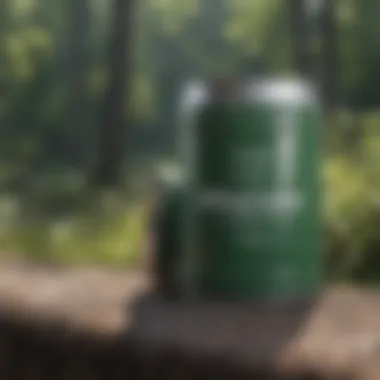Proper Disposal of Old Paint Cans: A Comprehensive Environmental Guide


Overview of the Topic
Current Challenges and Concerns
The current state of old paint can disposal poses significant challenges to both environmental and human health. Improper disposal methods, such as dumping paint cans in regular trash bins, can lead to soil and water contamination, posing risks to wildlife and ecosystems. Lack of awareness about safe disposal practices further exacerbates the issue, highlighting the need for education and proactive measures.
Sustainable Practices and Solutions
Exploring sustainable solutions for old paint can disposal involves various strategies aimed at reducing environmental impact and enhancing resource efficiency. Implementing recycling programs for empty paint cans, promoting the use of eco-friendly paint products, and encouraging responsible disposal habits among consumers are essential steps towards addressing the challenges associated with paint can waste.
Impact and Conservation Efforts
The improper disposal of old paint cans can have far-reaching consequences on ecosystems, communities, and future generations. By recognizing the impact of this issue, individuals and organizations can prioritize conservation efforts and sustainable resource management practices. Emphasizing the importance of proper paint can disposal is paramount in ensuring a cleaner environment and healthier communities for generations to come.
Understanding the Importance of Proper Disposal
Properly disposing of old paint cans is a crucial aspect of environmental responsibility and safety. Improper disposal can have severe repercussions on the environment and human health, making it imperative to understand the importance of following correct disposal procedures. By disposing of paint cans appropriately, we can mitigate the environmental impact of hazardous chemicals and reduce health risks associated with toxic substances. This section delves deep into the significance of proper disposal methods and highlights the key elements to consider.
Environmental Impact of Improper Disposal
The hazards of paint chemicals leaching into the soil
When old paint cans are irresponsibly disposed of, the hazardous chemicals they contain can seep into the soil, contaminating the earth and posing a significant threat to ecosystems. Paint chemicals leaching into the soil can disrupt its natural composition, affecting plant growth and soil fertility. This process not only degrades the quality of the soil but also contributes to the pollution of groundwater sources. By exploring the impact of paint chemicals on soil, we gain a profound insight into the environmental consequences of improper disposal.


Impact on water sources and aquatic life
Improperly disposed paint cans can have a detrimental effect on water sources and aquatic life. When paint chemicals leach into water bodies, they can contaminate drinking water supplies and harm aquatic organisms. The toxic substances present in paint can disrupt the aquatic ecosystem, leading to devastating consequences for biodiversity. Understanding how improper disposal affects water sources and aquatic life underscores the urgency of adopting proper disposal practices to safeguard our natural habitats.
Health Risks Posed by Incorrect Disposal
Exposure to toxic fumes and substances
Incorrectly disposing of old paint cans can expose individuals to toxic fumes and substances, posing serious health risks. Inhaling these fumes can result in respiratory issues, dizziness, and other adverse health effects. Moreover, direct contact with these substances can lead to skin irritations and potentially harmful outcomes. By shedding light on the health risks associated with improper disposal, we underscore the importance of prioritizing safety measures when handling old paint cans.
Potential risks of skin contact or ingestion
The potential risks of skin contact or ingestion stemming from improper paint can disposal are significant. Skin exposure to paint chemicals can cause irritation, allergies, or more severe dermatological conditions. Ingesting or accidentally swallowing these substances can result in poisoning, which can have severe consequences on one's health. Exploring the risks associated with skin contact or ingestion highlights the critical need for safe and responsible disposal practices to protect human health and well-being.
Finding Proper Disposal Facilities
In the realm of environmental sustainability, understanding how to locate appropriate disposal facilities for old paint cans is paramount. Not only does this practice uphold environmental and health standards, but it also showcases a commitment to responsible waste management. By engaging in the search for proper disposal facilities, individuals can actively contribute to the preservation of our ecosystem and the health of society as a whole. This section focuses on elucidating the significance of finding the right facilities for paint can disposal, shedding light on key considerations and benefits that underscore the necessity of this endeavor.
Local Recycling Centers
Researching nearby centers that accept paints:
When it comes to dealing with old paint cans, researching nearby centers that accept such items plays a pivotal role in responsible disposal practices. This aspect emphasizes the importance of proximity and accessibility to designated facilities, allowing for convenient and efficient disposal. By identifying and utilizing these local centers, individuals not only streamline the disposal process but also contribute to the reduction of environmental hazards associated with improper paint can disposal. Researching nearby centers that accept paints is a practical and beneficial choice, considering its direct impact on mitigating environmental pollution and promoting sustainable waste management.
Understanding specific guidelines for paint disposal:


Delving into the nuances of understanding specific guidelines for paint disposal elucidates the intricate regulatory frameworks governing this process. This aspect underscores the significance of adhering to established protocols and standards when disposing of old paint cans. By familiarizing oneself with these guidelines, individuals can ensure compliance with legal requirements and contribute to creating a safer and healthier environment. Understanding the specific guidelines for paint disposal offers a structured approach to handling hazardous materials, thereby enhancing environmental protection and fostering a culture of responsible waste management.
Hazardous Waste Collection Programs
Utilizing municipal or county programs for hazardous waste:
The utilization of municipal or county programs for hazardous waste signifies a collaborative effort between authorities and citizens to address the challenges of hazardous material disposal. By leveraging these specialized programs, individuals can access designated waste management services tailored to handle hazardous substances like old paint cans. This initiative not only promotes community involvement in sustainable practices but also facilitates the safe and efficient disposal of potentially harmful materials. Utilizing municipal or county programs for hazardous waste exemplifies a proactive approach towards environmental conservation and sets a precedent for responsible waste disposal methods.
Ensuring compliance with regulations:
In the realm of hazardous material disposal, ensuring compliance with regulations is a fundamental aspect that underpins the integrity of waste management practices. By prioritizing adherence to regulatory frameworks, individuals demonstrate a commitment to upholding environmental standards and safeguarding public health. Moreover, compliance with regulations serves as a safeguard against potential environmental risks, ensuring that hazardous materials are handled and disposed of in a manner that minimizes negative impacts. By focusing on compliance, individuals contribute to the maintenance of ecological balance and the preservation of natural resources. This section emphasizes the importance of aligning disposal practices with established regulations to promote sustainability and mitigate environmental harm.
Preparing Old Paint Cans for Disposal
In the intricacies of proper paint can disposal lies the cornerstone of environmental stewardship and safety. Before venturing into the labyrinth of disposal methods, it is imperative to understand the essence of preparing old paint cans for their final journey. This crucial step ensures not only the security of the handlers but also mitigates potential environmental hazards profoundly.
Properly Sealing and Labeling Cans
Securing lids to prevent spills
Within the milieu of preparatory actions, securing lids on paint cans emerges as a linchpin in averting disasters. This seemingly mundane task holds immense significance in forestalling potential spills that could prompt calamitous consequences. The efficacy of sealed lids lies in their ability to trap volatile paint compounds within the confines of the can, thwarting any untoward leakage. Implementing a secure lid seal not only safeguards the environment but also ensures the safety of those handling the cans, marking it as an indispensable practice embedded within the realm of proper paint can disposal.
Unraveling the unique characteristic of securing lids unveils a straightforward yet pivotal function. By encapsulating the hazardous contents within the can, spillage risks are dramatically reduced, fortifying the safety net of both individuals and surroundings. This practice hastens the transition of paint cans from potential environmental hazards to manageable disposables, amplifying its preeminence in the overarching goal of responsible paint can disposal.
In essence, securing lids is a foundational practice in the meticulous choreography of preparing old paint cans for disposal, underlining its paramountcy in fortifying environmental wellness and personal safety within the disposal process.


Clearly marking cans as hazardous waste
Embarking on the journey of labeling paint cans as hazardous waste signifies a deliberate act of transparency and caution. The meticulous process of marking these receptacles holds multifaceted benefits, chiefly in delineating the potential dangers housed within. By unequivocally identifying the cans as hazardous waste, a clear hazard warning is issued, cautioning against mishandling or improper disposal.
The salient feature of clear marking lies in its unequivocal communication of the contents' perilous nature, serving as a beacon of guidance for all involved in the disposal chain. This discernible identification not only safeguards individuals from inadvertent exposure but also streamlines the disposal process by ensuring compliance with regulatory standards.
The unique facet of clearly marking cans as hazardous waste lies in its dual function of cautionary signaling and regulatory adherence. By prominently labeling cans, the disposal process becomes not only streamlined but also fortified in its commitment to environmental preservation and occupational health.
Disposal Methods for Old Paint Cans
Properly disposing of old paint cans is a critical aspect of environmental responsibility and safety. This section delves into the various methods available for the disposal of old paint cans, highlighting the importance of choosing environmentally friendly options. By exploring the benefits and considerations of different disposal methods, individuals can make informed decisions that minimize harm to the environment and human health.
Landfill Disposal
Understanding regulations for landfill disposal of paint
Understanding the regulations governing the disposal of paint in landfills is integral to ensuring compliance with environmental policies. By adhering to specific guidelines on how paint containers should be disposed of, individuals can mitigate the negative impact of hazardous materials on the environment. The key characteristic of understanding these regulations lies in promoting a safe and sustainable approach to waste management. While this method is a popular choice due to its simplicity, it is essential to note that improper disposal can lead to detrimental consequences for both the ecosystem and public health. Therefore, understanding and following landfill disposal regulations are crucial steps in the proper disposal of old paint cans.
Potential drawbacks and environmental concerns
Despite its convenience, landfill disposal of paint cans raises significant environmental concerns. The primary drawback stems from the potential leaching of harmful chemicals into the soil and groundwater, contaminating local water sources and posing risks to aquatic life. Additionally, the accumulation of non-biodegradable paint can contribute to long-term environmental degradation. These drawbacks highlight the importance of exploring alternative disposal methods that prioritize sustainability and the reduction of environmental impact.
Paint Recycling Options
Exploring opportunities for recycling paint products
Exploring opportunities for recycling paint products presents a sustainable solution to reduce waste and environmental harm. By repurposing old paint, individuals can contribute to the circular economy and minimize the depletion of natural resources. The key characteristic of paint recycling lies in its ability to transform waste into valuable material, promoting resource efficiency and environmental conservation. While this option requires initial effort in sourcing appropriate recycling facilities, the long-term benefits of reducing waste and conserving resources outweigh the challenges.
Benefits of paint reuse and recycling
The benefits of paint reuse and recycling are multifaceted, ranging from waste reduction to energy conservation. By reusing paint or recycling its components, individuals can lower carbon emissions associated with manufacturing new products. Additionally, recycling paint supports the creation of a sustainable supply chain and fosters innovation in resource recovery. Embracing paint reuse and recycling not only reduces the environmental footprint of disposal but also contributes to a more circular and resource-efficient economy.



